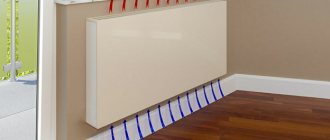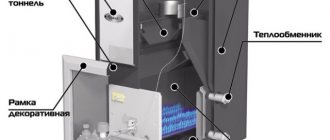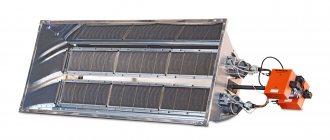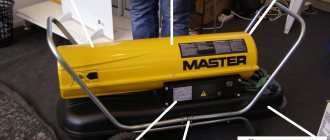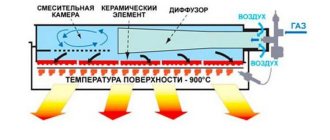Infrared heaters are currently very popular among consumers.
They can easily compete with any heating device. Such as an oil radiator, convectors, split system with heating system. The operating principle of heaters is based on the emission of infrared waves, which initially heat surrounding objects, which in turn release heat into the air in the room. Warm air rises and heats the entire space of the heated room.
Selecting a heater depending on wavelength
The emitted waves can be of different lengths. According to this principle, infrared heaters are:
- Short wavelength, t up to 800 C, length 0.74-2.5 µm;
- Medium wave, t up to 600 C, length 2.5-50 µm;
- Long wavelength, t no more than 300 C, length 50-2000 µm.
The efficiency of heating depends not only on the wavelength, but also on the area of the heated room.
Short-wave heaters are mainly used for small rooms and for local local heating, for example, outdoors in a gazebo, heating a specific place in the room. When using such a device, it is necessary to remember that the shorter the infrared wave, the more detrimental its effect on the human body. With prolonged exposure, waves can cause redness on the skin, dry out the mucous membranes of the eyes and cause such a serious disease as cataracts. Therefore, if you need to heat a small house, cottage or apartment, or a greenhouse in the country, it is better to purchase an infrared medium-wave heater. They have virtually no effect on the human body and are absolutely safe.
Long-wave infrared heaters are used to heat large rooms, mainly on an industrial scale.
Infrared heaters, depending on the energy source, can be divided into three types:
- Electrical;
- Based on liquid fuel;
- Gas.
Let's look at each type in more detail.
Which models do consumers prefer ↑
Among today's Russian consumers, at least among those who use Internet information, as we found out, one of the popular brands is ceiling heaters "Peony" , you can read more about it here.
Basically, two of the possible types are used for heating dachas (and any auxiliary utility premises). Warm floors are being installed. Or the infrared heating system is mounted on the ceiling. The latter, by the way, seems to be one of the most optimal options, since it provides heating first of all living things, and then of the actual floors in the room.
Several options for such a device can be considered.
Film heaters. What are they? These are multilayer resistors placed between two layers of film. Resistors are attached between the thermal insulation and the ceiling covering itself. The radiation of the film is 15 microns, and it is evenly distributed in the room. In this case, the ceiling plays the role of both a heating and reflective element.
A ceiling-type infrared heater is usually made in the form of a flat plate with installation containers. Despite the definition of “ceiling-mounted,” such heaters can also be mounted on walls, if this option suits you better. But ceiling placement is recommended for the simple reason that heat is distributed more efficiently.
Infrared heater is best mounted on the ceiling
The device has a very specific range of action. It is within its boundaries that the so-called thermal spot is formed. And the higher the device is placed, the greater the coverage area, but the degree of heating, accordingly, is less.
Electric infrared heaters
Electric heaters are widely used in everyday life and industry. Spirals, threads or heating elements are used as a heating element.
Electric IR heaters are:
powered from a single-phase 220V network. They are used for heating apartments, houses, shops, cottages, garages, etc.;
household,- industrial, operating from a three-phase 380V network. Used in factories, in places for local heating, for example warehouses, workplaces. They are designed for heating large areas.
If we classify infrared heaters by heating element, they are:
- Ceramic;
- Halogen;
- Carbon (film);
- Quartz;
- Micathermic;
- Liquid fuel;
- Gas.
conclusions
Safe heating in a dacha is not difficult to organize, but you must choose the right device. Today, the best solution is an IR heater. The initial investment in its purchase is of course higher than that of a conventional convector or oil heater, but its efficiency and the presence of a thermostat will help you save money right away. And besides, not every heating device can be used outdoors, but this does not apply to IR, they can work equally effectively both indoors and outdoors.
Halogen infrared heaters
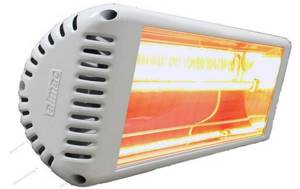
Halogen lamps are used as the heating element of such heaters. They are glass tubes with tungsten filaments installed inside them. When current flows, the filament heats up to a red glow, due to which infrared radiation occurs.
To protect against overheating of the lamp and breakage of the tungsten filament, an inert gas is present in the tube. Therefore, in order for the heater to serve for a long time, it must be protected from mechanical damage, shock from falling and liquids coming into contact with the lamps.
In real life, such heaters are rarely used due to high energy consumption.
Heater SUPRA IR 1000W
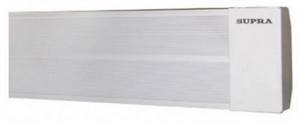
A powerful heater that combines the functions of electrical power and absorbs gas. A large device that requires a separate place. Safe. During operation it emits a pleasant yellow color. Available in white and chrome. The average cost on the market is 5,000 rubles. Rarely found on sale, mostly purchased to order.
Carbon infrared heaters
They are considered one of the varieties of halogen heaters. They differ in the design of the lamp. Instead of metal thread, carbon mineral fiber is used in such models.
Such heaters are produced with different numbers of heating elements from 1 to 4 pieces in one model. The power of the heater depends on the number of elements.
The advantages of such heaters include:
- Low power consumption;
- Resistant to voltage surges;
- Moisture resistant;
- They have increased heat flow.
This type is mostly used by summer residents to heat polycarbonate greenhouses.
thermostat Ballu BMT-1
A mechanical thermostat designed specifically to work in conjunction with IR heaters of this brand. The range of adjustable temperatures is from +10°C to +30°C. Compatible with single-phase heaters up to 2 kW. The thermostat housing is made of impact-resistant white plastic. On the front panel there is an LED indicator of the device operation.
Characteristics:
- dimensions - 83x83x38 mm;
- weight - 165 g.
Cost 615 rub.
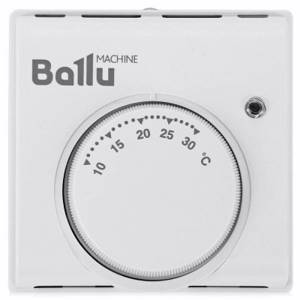
Quartz infrared heaters
Quartz heaters can be purchased in two types - tubular and monolithic.

Tubular heaters are somewhat similar in design to halogen heaters. The heating elements are quartz glass tubes, inside of which a current heating wire is placed. The efficiency of such heaters is much higher due to the use of quartz glass. At maximum power, efficiency can reach up to 95%.
Monolithic heaters are designed as a solid platinum in which a heating element is located. This is a current-carrying conductor made of chromium-nickel alloy. When this platinum is heated, infrared radiation is produced. The monolith design is protected from overheating and moisture. The efficiency of heaters of this series reaches 80%.
BiLux T08
Programmable thermostat with touch display and backlit screen. It has a high moisture protection class, which allows operation in conditions of high humidity. Two control modes: manual and programmable. The thermostat attracts attention with its modern stylish design, is equipped with a temperature sensor with a connecting wire 3 m long. It has the function of storing a given program, and after an emergency shutdown it starts working in the same mode. Regulates temperature in the range of +5-30°C.
Characteristics:
- dimensions - 100x100x60 mm;
- weight - 220 g.
Cost 2990 rub.
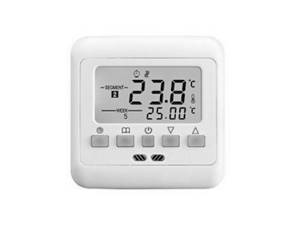
Micathermic infrared heaters
Externally, these heaters are similar to oil radiators. The design of the IR device consists of thin plates that act as a current conductor. The plates, in turn, consist of thin metal layers. When current is applied, the plates conduct thermal infrared waves and do not heat up at all. This is possible due to the fact that each plate is covered with a layer of mica. In addition, each heater is equipped with metal grilles.
The design of the micathermic IR device allows heated air to circulate in the room using the convector principle, which is one of the advantages of this heater. The efficiency of the devices is almost 98%. They are durable in use.
Heat spot ↑
Experts explain the high efficiency of ceiling heaters by the fact that the floor inevitably falls into this warmest spot, which significantly increases the comfort of the home. The heat spot of wall-mounted devices captures the opposite wall, to which the distance is usually greater than from the ceiling to the floor. Therefore, in the latter case, heat is dissipated more during the heating process, and accordingly the room takes longer to heat.
The choice of device by the consumer depends, first of all, on the size of the room. Judging by the reviews of experienced summer residents, for effective heating you will need approximately 100 W per 1 sq. m. meter of room. However, a number of other considerations should be taken into account. What other parameters are important?
Bottom line. It is highly advisable to maintain a distance of about a meter between the heating panel and the person’s head. Otherwise there may be overheating. Upper limit. It is set by the ceiling height and the power of the specific heater. So, at a height of 2.5 m, a device with a power of 1.2 kW will create a heat spot, the radius of which will be two meters. This is about 16 square meters. meters of area. Power. It is calculated based on the area of a particular room. It is considered effective to install not one, but several devices; they are mounted in parallel. When calculating the required power, you should take into account the number of windows, as well as the degree of thermal insulation of the building.
Gas infrared heaters
These are high-power heaters and are usually used on an industrial scale. The operating principle of gas heaters is based on the combustion process of gas (propane, butane, butylene, natural or liquefied gas) and air on special heater plates. When burned, the heating element heats up and emits heat in the form of infrared waves. According to the design of the combustion chamber, there are open or closed types.
Ceramic gas heaters include open chambers. They are available in both large and small sizes. In domestic conditions, they are used as portable devices and are used to heat small rooms, cottages, and utility rooms. During the combustion of gas, combustion products are released. Therefore, the heated room must be well ventilated.
Tubular gas heaters have a closed combustion chamber. The heating element is tubes. The air, moving through the tubes, gives them its energy and thereby increases the temperature of the outer walls to 300 degrees. The generated heat is emitted in the form of infrared rays and moves to the bottom using a reflector.
Heaters of this type are expensive to use and install. Therefore, their use in everyday life is limited.
Types of heating elements
When buying an infrared heater, you need to pay attention not only to the type of heating element itself, but also what material its shell is made of. It can be made of metal, ceramic or quartz. Heating elements can also be of several types.
Halogen heating element
This heating element is made in the form of a halogen lamp emitting at an infrared wavelength. The lamp core contains a filament made of tungsten or carbon fiber. When current passes through the filament, it heats up and emits energy in the infrared range. The energy is transferred to the lamp tube.
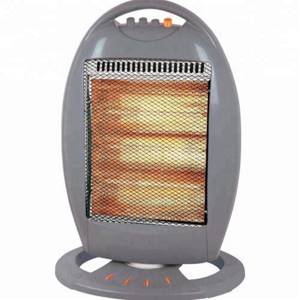
The specificity of lamps of this format is that their radiation, firstly, is not comfortable for the human eye. Manufacturers try to neutralize this effect by applying protective paint to the lamp. Secondly, radiation of such a short wavelength is harmful to humans. Therefore, a heater with such a heating element is not recommended for purchase.
Carbon heater
This heating element is a quartz tube sealed on both sides. Inside it there is a core (spiral) made of carbon, and a vacuum is created around it.
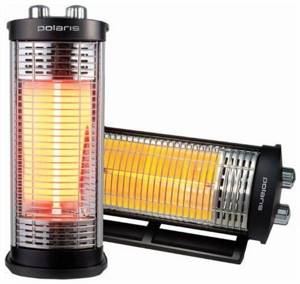
This NE also has its own specifics.
Advantages:
- quick access to operating temperature;
- high efficiency.
Flaws:
- service life no more than 2 years;
- red light radiation, which has a negative effect on asthmatics and allergy sufferers.
Carbon heaters are used as a standby option for infrequent and short-term operation.
Ceramic
The operating principle of this heating element is the same as that of a carbon one. The difference is that its tube has a ceramic coating. Ceramics removes harmful glow and increases the overall service life to 3 years. A ceramic heating element is more expensive than a carbon one, but over time, thanks to the nuances of the design, the difference in price is compensated.

Ceramic heaters are quite inertial. They are most widely used in hospitals and saunas.
Tubular (micathermic)
The heating element is a plate with an insulating layer of mica in a metal casing. It gives very comfortable warmth. Heaters of this type are reliable and safe, and last a long time. This is the best choice for home.
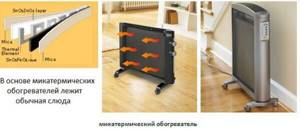
During operation, an IR heater of this type emits a quiet crackling sound associated with uneven thermal expansion of the aluminum body and steel coil.
When buying a heater with a tubular element, you need to pay attention to the quality of the housing, the condition of the heating element, insulating element and emitter.
Liquid fuel infrared heaters
These heaters are used to heat houses located far from electrical networks. These include:
. They are more like an oven. Some models have a hob at the top for cooking. They are produced in small sizes and low power.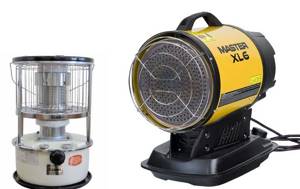
Household kerosene IR heaters- Diesel IR heaters . They are also called heat guns. During combustion, heated fuel passes through a narrow nozzle at high speed and transfers heat to a metal grate, which emits infrared rays. In this way, the heated air is distributed as much as possible throughout the room. These devices are not used in domestic conditions. Disadvantages include high fuel consumption, noise and the presence of a good ventilation system.
Advantages of infrared heaters:
- IR heaters heat objects, not air, in the room. Air circulates evenly throughout the entire area;
- The efficiency of these heaters is close to 90%. Energy consumption is less than traditional heaters. All energy goes to heating. Each device is equipped with a thermostat that turns off the heater when the desired temperature is reached;
- When heated, IR heaters do not reduce the oxygen content in the air;
- Safer to use than traditional devices;
- Environmentally friendly. In the production of IR heaters, toxic substances that can negatively affect human health are not used;
- Easy to install and use.
Installation methods
Another significant difference between infrared heaters is their ease of installation and versatility.
They can be placed at any angle to heated surfaces and oriented differently in space.
The panels are mounted on walls, but it is possible to install them on the ceiling or floor. The direction of heating will depend on this: from below, from above and from the side. This versatility has found wide application in interior design; the required direction of thermal radiation can be taken into account at the design stage.
In order to save money, you should carefully approach the organization of heating systems and optimize them as much as possible. The correct choice of heating devices plays an important role. And it is impractical to leave aside such a technological novelty as infrared heaters. Considering all the advantages of this type of heaters, they can be used for almost any task.
Selecting an IR heater
When choosing an IR device, you need to take into account some points, namely:
- Consider how it will be used. Is this the main source of heating or additional;
- For what heated area is the heater purchased? Based on this, a heater of appropriate power is selected;
- Thickness and material of walls;
- Ceiling height, presence and type of room on the top floor. It is necessary to consider which room is above your ceiling (street roof or living room);
- Window glazing in the room (old wooden or plastic with double glazing).
Considering the above factors, you can choose the right infrared heater.
Popular models. Videos and tests ↑
I will consider here some of the models popular among users from well-known manufacturers.
To find the most suitable infrared heater for your room, there are many parameters that should be taken into account. The first thing, of course, is to start from the area. You also need to take into account whether this will be the main heating or auxiliary (in addition), as well as such a very important aspect as the thermal insulation of the room - you need to evaluate how effective it is in your home, because you still won’t heat the street in severe frosts. For a more or less simple calculation, you can easily use such a simple selection table.
| Power, W/Heating, m2 | Main heating | Additional heating |
| 800 | 8 | 16 |
| 1000 | 12 | 20 |
| 2000 | 20 | 40 |
| 3000 | 30 | 60 |
| 4000 | 40 | 80 |
Reviews
“It’s warm, but it CRACKS!!” Evgeniy from February 3, 2021
I purchased a heater to heat a 12 sq.m. bedroom. Beauty, very pleased. Heats up very quickly and operates quietly. Occasionally it only cracks after prolonged use. The case has a temperature sensor, which is convenient. It turns itself off. I recommend to everyone!
Resanta IKO-1500. Sergey from September 20, 2021

I brought a 1500-watt Resanta heater to heat the billiard room. I considered that it was not profitable to install central heating. At first I didn’t believe that it would be warm. Billiard room 25 sq.m. In the end, it was great, the heater worked. Maintains a stable 18-20 degrees.
Pros: heats well, relatively portable.
Cons: subjective – looks very gentle
“It depends on what kind of IR. But better – wall-mounted ones.” Andrey from February 9, 2018
We bought infrared for heating the house. Gas is expensive to carry. Relatives recommended buying this device. We were very impressed by the quality of the panels. Heats up the room quickly. We have an insulated house, so we didn’t have to wait long.
Pros: Doesn’t take up space, economical, beautiful
Cons: Heavy
Basically, all customers were satisfied with the IR heaters. Their heating speed, ease of use and installation. Some appreciated it for its small size and economy. The ability not to “burn” oxygen in the air. The main thing is to choose the right heater for the heated area.
How to buy a truly high-quality product when choosing an IR ceiling panel
There is one interesting point - sometimes the foil under the radiating profile is set to a narrower width than required. Because of this, small gaps remain along the perimeter of the foil between it and the body. This will not affect the quality of heating in any way, but dust and small glass fragments may fall from the mineral wool onto the floor. Therefore, you need to carefully check that there are no gaps between the foil and the body of the device.
It is worth paying attention to the performance of the indicators that are built into the heater. Sometimes during assembly, craftsmen may not notice that any sensors are not working, and then you will have to think and guess whether the device is turned on or not.
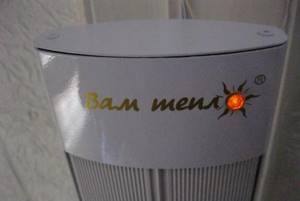
Working indicator of the ceiling IR heater
Next, inspect the heater body - there should be no dents or signs of repair on its surface. If there are such traces, then most likely you have a device that has already been in use, and someone for some reason returned it to the seller. Unfortunately, not all stores are conscientious about their work and may well put up a defective device for re-sale.
Well, the last moment. Make sure that all fasteners required to install the heater are included in the kit. So that later you don’t waste time going to the store for the necessary dowels and hangers.
And a few words about the installation features...
The most popular infrared heaters
- Almak is considered the most economical. The cost is not high. The body is made of aluminum. Due to the use of this material in manufacturing, its weight is reduced and its service life is increased.
- Ecoline is probably the most common IR heater. It has high efficiency, is mobile when moving, and has a service life of up to 30 years if used correctly;
- Bilux is characterized by the rapid heating and cooling of the heating element. Widely used both at home and in production.
Device design
To understand how this electrical appliance works and what the basic principle of operation is, you need to have an idea of its components. The body is usually made of steel, and the surface is powder coated. Inside it there is an aluminum reflector to which a heating element is attached. Thus, an infrared heater is similar to a heating lamp or panel, inside which a beam of infrared radiation is collected. They operate regardless of the direction of air and the speed of movement of warm and cold air masses.

The operating principle of an infrared heater is similar to the effect of the sun on the atmosphere. The sun's rays also penetrate the surface, which in turn absorbs heat.
Advantages and disadvantages
Infrared heaters with a thermostat are modern heating devices. Despite their relatively recent appearance on the heating equipment market, they were able to gain wide popularity among users.
The great demand for such products is due to a number of advantages highlighted in their operation:
- By installing such a device indoors, you will be provided with fast and uniform heating; even in large rooms, heat is supplied in a very short time.
- High efficiency, since the installed thermostat provides the specified temperature conditions, on average, the IR heater operates for 11-12 hours per day. This means that electricity costs will be at least half as much.
- High efficiency, reaches 95-100%.
- The device is quite simple to operate, because it is very convenient to select the desired temperature mode and go about your business. When the temperature reaches the maximum level, the infrared heater will turn off itself, and after the air in the room has cooled, it will start working again.
Panel ceiling-wall infrared heater Royal Clima RIH-R800G with thermostat
- High level of security. By installing such equipment, you will be protected from possible overheating, because... The automatic sensor itself maintains the desired temperature level.
- The infrared heater does not make any distracting sounds during operation.
- When the device is working, oxygen is not burned and the natural level of humidity is maintained.
- Mobility. You can move such devices to any place.
- A wide selection of designs and colors allows you to choose the appropriate IR heater that will fit into any interior.
Despite the abundance of advantages, such heaters also have some disadvantages:
- The room is heated zonally. On the one hand, this factor is a plus, but, on the other hand, the comfort zone is significantly limited.
- Many people talk about the dangers of infrared heaters for human health. According to all expert opinions, such devices do not have a negative effect, but the risk of an individual allergic reaction cannot be excluded.
You should not stay near the heater for a long time. Since prolonged direct exposure to infrared rays on the eyes is fraught with burns to the cornea.
Considering the possible negative consequences that infrared heaters can have, you should strictly follow all recommendations and requirements regarding installation and operation. In no case should you choose a place where there is direct exposure to a person, for example, above a bed.
Principle of operation
In order to understand how an IR heater functions, let us turn to the operation diagram of a classical heating system.
In the first case, the room is supplied with heat thanks to the heat transfer of the device itself. During the heating process, its walls give off heat, due to which the room warms up. This heating principle is simple, but it is not highly efficient either, since it is limited by the size of the device itself.
In another case, heating is carried out according to the principle of convection.
With this heating method, heat exchange is carried out due to the forced circulation of warm air masses. The set of such devices may also include special fans that create convection currents. This heating method is much more effective than devices with a standard heat exchanger, but it also has a number of disadvantages: heat is not always distributed evenly throughout the room, in addition, such heating devices are quite noisy; during their operation, dust may be released and drafts may form.
You can read more about the types of IR electric heaters here.
The operating principle of an infrared heater with a thermostat is completely different from the two described above.
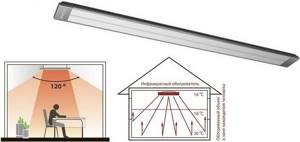
The principle of heating with an IR heater
The room is heated by electromagnetic waves that spread throughout the room. These waves are in a given range: between the red end of the spectrum of visible light (wavelength - 0.74 microns) and the region of microwave radio emission (from 1000 to 2000 microns).
If we compare an IR heater and a conventional heating system, the efficiency of the former is much higher. This is also noted by the owners of such heaters.



